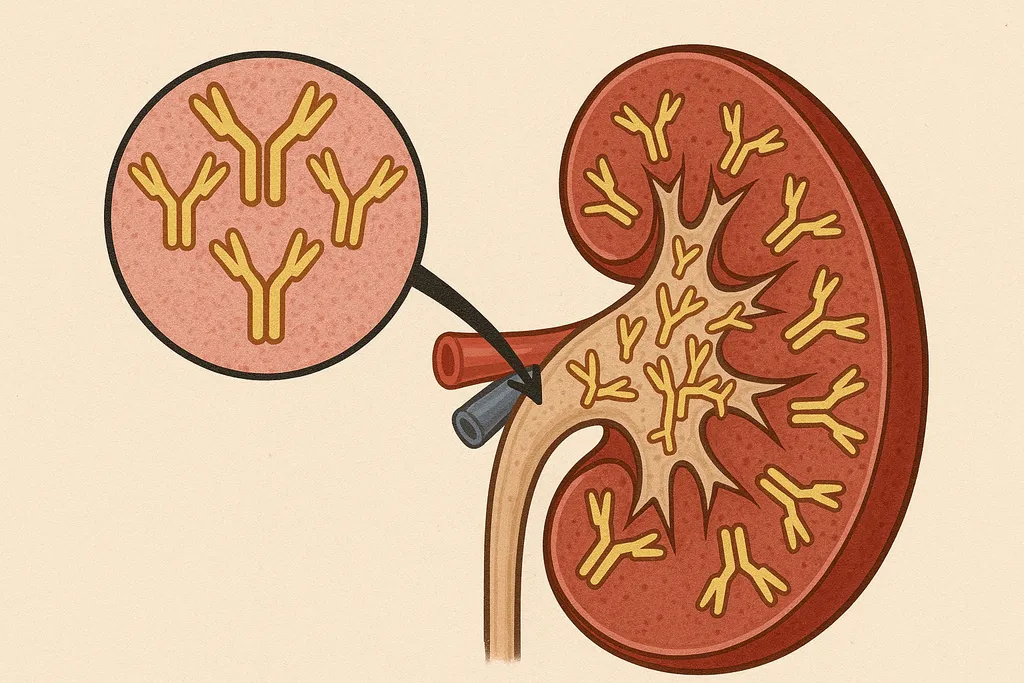What are the Symptoms of Multiple Myeloma?

Multiple myeloma can present itself in a myriad of ways, but unfortunately, these symptoms can be identical to the symptoms of old age, such as back and bone pain and increased fatigue.
It's important to note that the symptoms of multiple myeloma can vary from person to person, and some individuals may not experience any symptoms in the early stages of the disease.
What are Multiple Myeloma Symptoms?
Common symptoms or presentations of multiple myeloma include the following:
-
Bone Pain: Bone pain, particularly in the back, ribs, and hips, is a common symptom. This pain can be persistent and worsen with movement or at night.
-
Fatigue: Many people with multiple myeloma experience fatigue, weakness, and a general feeling of being unwell. This is often due to the impact of the disease on bone marrow function.
-
Anemia: Multiple myeloma can lead to a decrease in red blood cell production, resulting in anemia. Anemia can cause fatigue, weakness, and shortness of breath.
-
Frequent Infections: Myeloma can weaken the immune system, leading to an increased susceptibility to infections.
-
Kidney Problems: Multiple myeloma can damage the kidneys, leading to symptoms such as increased thirst, frequent urination, and fluid retention.
-
High Calcium Levels (Hypercalcemia): Elevated calcium levels in the blood can cause symptoms like excessive thirst, nausea, constipation, confusion, and kidney problems.
-
Recurrent Infections: Weakened immune function can lead to a higher risk of infections, including pneumonia and urinary tract infections.
-
Unexplained Weight Loss: Some individuals with multiple myeloma experience unexplained weight loss.
-
Nausea and Constipation: These symptoms can result from kidney problems, hypercalcemia, or the side effects of certain medications used to treat multiple myeloma.
-
Neurological Symptoms: In rare cases, multiple myeloma can affect the nervous system, leading to symptoms like weakness, numbness, or problems with coordination.
What is CRAB and How Does It Relate to Multiple Myeloma Symptoms?
CRAB is an acronym used to describe the major clinical features and symptoms associated with multiple myeloma. It is a convenient way to remember and categorize the primary manifestations of the disease.
The CRAB criteria are as follows:
-
C - Calcium (Hypercalcemia): Elevated calcium levels in the blood, known as hypercalcemia, are the "C" of the CRAB criteria. In multiple myeloma, the abnormal activity of plasma cells can lead to the release of calcium from the bones into the bloodstream, causing symptoms such as excessive thirst, nausea, constipation, confusion, and kidney problems.
-
R - Renal (Kidney Dysfunction): Kidney problems are another key feature of multiple myeloma. The disease can damage the kidneys, leading to symptoms like increased thirst, frequent urination, and fluid retention. This is often due to the presence of abnormal proteins produced by myeloma cells, which can clog the filtering structures in the kidneys.
-
A - Anemia: Anemia is a common finding in multiple myeloma. It results from the cancer's impact on the bone marrow, where plasma cells proliferate and crowd out other blood cell-producing cells. Anemia can cause fatigue, weakness, and shortness of breath due to a reduced number of red blood cells.
-
B - Bone Lesions (Bone Pain): Bone involvement is a hallmark of multiple myeloma. The cancer cells can accumulate in the bones, leading to bone pain, especially in areas like the back, ribs, and hips. These painful bone lesions can weaken the bones and increase the risk of fractures.
The presence of one or more of these CRAB criteria is an indication of active and symptomatic multiple myeloma.
Healthcare providers often use these criteria to help diagnose and stage the disease, as well as to determine the need for treatment.
In addition to the CRAB criteria, other tests and assessments, such as blood tests, imaging studies, and bone marrow biopsy, are typically performed to confirm a diagnosis and assess the extent of the disease.
It's essential to consult with a healthcare professional if you or someone you know is experiencing symptoms that may be related to multiple myeloma.
Early diagnosis and appropriate treatment can help manage the condition and improve outcomes.
Does Precursor Multiple Myeloma (MGUS and Smoldering) Present with Symptoms?
Precursor conditions to multiple myeloma, such as Monoclonal Gammopathy of Undetermined Significance (MGUS) and Smoldering Multiple Myeloma (SMM), do not typically present with the classic CRAB symptoms (Calcium elevation, Renal dysfunction, Anemia, and Bone lesions) associated with active and symptomatic multiple myeloma.
However, these precursor conditions can have their own set of subtle or mild symptoms and characteristics, which are different from those seen in active myeloma:
-
MGUS (Monoclonal Gammopathy of Undetermined Significance):
- MGUS is a condition in which a person has an abnormal protein (monoclonal protein or M-protein) in the blood but does not meet the criteria for multiple myeloma.
- People with MGUS typically do not experience any myeloma-related symptoms, such as bone pain, anemia, or kidney problems.
- MGUS is often discovered incidentally during routine blood tests, and it is typically asymptomatic.
-
SMM (Smoldering Multiple Myeloma):
- Smoldering myeloma (SMM) is a more advanced precursor condition than MGUS, characterized by a higher level of monoclonal protein in the blood and more abnormal plasma cells in the bone marrow.
- While individuals with smoldering myeloma do not meet the criteria for active myeloma, they may have subtle symptoms like bone pain or low-level anemia in some cases.
- Smoldering myeloma is considered an intermediate stage between MGUS and symptomatic myeloma, and it carries a higher risk of progression to active myeloma over time.
It's important to note that most people with MGUS or SMM do not develop multiple myeloma, and these conditions are often stable and do not require immediate treatment.
However, individuals with precursor conditions are typically monitored by healthcare providers to track changes in their condition and assess the risk of progression to symptomatic myeloma.
Regular check-ups, blood tests, and other diagnostic tests are used to monitor the disease's progression and help determine when intervention or treatment may be necessary. If you have MGUS or SMM, it is essential to follow your healthcare provider's recommendations for ongoing observation and care.
How Can I Manage My Multiple Myeloma Symptoms?
Managing multiple myeloma symptoms typically involves a comprehensive approach that may include medical treatment, supportive care, and lifestyle modifications.
It's important to work closely with a healthcare team, which may include myeloma specialists, oncologists, hematologists, nurses, and other specialists, to develop a personalized treatment plan.
Here are some strategies to manage myeloma symptoms:
-
Medical Treatment:
- Treatment options for multiple myeloma may include chemotherapy, targeted therapy, immunomodulatory drugs, and, in some cases, stem cell transplantation.
- Bisphosphonates can be used to strengthen bones and reduce the risk of fractures.
- Monoclonal antibodies and other novel therapies may also be part of the treatment plan.
- Your healthcare provider will determine the most appropriate treatment based on the type and stage of your myeloma.
-
Symptom Management:
- Pain relief: Medications, physical therapy, and other pain management techniques can help alleviate bone pain.
- Anemia management: Treatment options may include red blood cell transfusions or erythropoiesis-stimulating agents.
- Kidney function: Addressing kidney problems may involve hydration, medications, and addressing the underlying cause.
- Hypercalcemia: Treatment for high calcium levels may involve fluids and medications to lower calcium levels.
-
Supportive Care:
- Regular follow-up appointments: Frequent check-ups and monitoring are essential to assess the status of the disease and manage symptoms.
- Nutrition: A balanced diet can help maintain overall health, manage anemia, and support the immune system.
- Exercise: Gentle, low-impact exercise can help with bone health and improve overall well-being.
- Pain management techniques: Physical therapy, relaxation exercises, and pain medications can be helpful for managing discomfort.
-
Bone Health:
- Protecting bones: Reducing the risk of fractures by taking precautions and avoiding activities that could lead to injuries.
- Medications: Bisphosphonates or other bone-strengthening medications may be prescribed.
-
Emotional Support:
- Seek emotional and psychological support through counseling, support groups, or individual therapy to cope with the emotional aspects of living with myeloma.
-
Financial Support:
- Multiple myeloma treatment can be expensive, so it's important to explore financial assistance options, such as insurance, government programs, or patient assistance programs offered by pharmaceutical companies.
-
Lifestyle Modifications:
- Maintain a healthy lifestyle with a balanced diet, regular exercise, and adequate rest.
- Avoid smoking and limit alcohol consumption to support overall health.
- Consult your healthcare team before making any significant dietary or lifestyle changes.
It's crucial to have open and regular communication with your healthcare team to discuss treatment options, manage side effects, and address any concerns.
Multiple myeloma is a complex condition, and the treatment approach may vary based on individual factors, such as the stage of the disease and overall health. Your healthcare team will guide you through the most appropriate management plan for your specific situation.
You can also see what other myeloma patients have done to manage these symptoms and what has worked for them and what hasn't by using our Side Effect Solutions tool. Remember to always discuss with your doctor before adding/removing anything from your standard diet and/or incorporating a large lifestyle change.
Multiple myeloma can present itself in a myriad of ways, but unfortunately, these symptoms can be identical to the symptoms of old age, such as back and bone pain and increased fatigue.
It's important to note that the symptoms of multiple myeloma can vary from person to person, and some individuals may not experience any symptoms in the early stages of the disease.
What are Multiple Myeloma Symptoms?
Common symptoms or presentations of multiple myeloma include the following:
-
Bone Pain: Bone pain, particularly in the back, ribs, and hips, is a common symptom. This pain can be persistent and worsen with movement or at night.
-
Fatigue: Many people with multiple myeloma experience fatigue, weakness, and a general feeling of being unwell. This is often due to the impact of the disease on bone marrow function.
-
Anemia: Multiple myeloma can lead to a decrease in red blood cell production, resulting in anemia. Anemia can cause fatigue, weakness, and shortness of breath.
-
Frequent Infections: Myeloma can weaken the immune system, leading to an increased susceptibility to infections.
-
Kidney Problems: Multiple myeloma can damage the kidneys, leading to symptoms such as increased thirst, frequent urination, and fluid retention.
-
High Calcium Levels (Hypercalcemia): Elevated calcium levels in the blood can cause symptoms like excessive thirst, nausea, constipation, confusion, and kidney problems.
-
Recurrent Infections: Weakened immune function can lead to a higher risk of infections, including pneumonia and urinary tract infections.
-
Unexplained Weight Loss: Some individuals with multiple myeloma experience unexplained weight loss.
-
Nausea and Constipation: These symptoms can result from kidney problems, hypercalcemia, or the side effects of certain medications used to treat multiple myeloma.
-
Neurological Symptoms: In rare cases, multiple myeloma can affect the nervous system, leading to symptoms like weakness, numbness, or problems with coordination.
What is CRAB and How Does It Relate to Multiple Myeloma Symptoms?
CRAB is an acronym used to describe the major clinical features and symptoms associated with multiple myeloma. It is a convenient way to remember and categorize the primary manifestations of the disease.
The CRAB criteria are as follows:
-
C - Calcium (Hypercalcemia): Elevated calcium levels in the blood, known as hypercalcemia, are the "C" of the CRAB criteria. In multiple myeloma, the abnormal activity of plasma cells can lead to the release of calcium from the bones into the bloodstream, causing symptoms such as excessive thirst, nausea, constipation, confusion, and kidney problems.
-
R - Renal (Kidney Dysfunction): Kidney problems are another key feature of multiple myeloma. The disease can damage the kidneys, leading to symptoms like increased thirst, frequent urination, and fluid retention. This is often due to the presence of abnormal proteins produced by myeloma cells, which can clog the filtering structures in the kidneys.
-
A - Anemia: Anemia is a common finding in multiple myeloma. It results from the cancer's impact on the bone marrow, where plasma cells proliferate and crowd out other blood cell-producing cells. Anemia can cause fatigue, weakness, and shortness of breath due to a reduced number of red blood cells.
-
B - Bone Lesions (Bone Pain): Bone involvement is a hallmark of multiple myeloma. The cancer cells can accumulate in the bones, leading to bone pain, especially in areas like the back, ribs, and hips. These painful bone lesions can weaken the bones and increase the risk of fractures.
The presence of one or more of these CRAB criteria is an indication of active and symptomatic multiple myeloma.
Healthcare providers often use these criteria to help diagnose and stage the disease, as well as to determine the need for treatment.
In addition to the CRAB criteria, other tests and assessments, such as blood tests, imaging studies, and bone marrow biopsy, are typically performed to confirm a diagnosis and assess the extent of the disease.
It's essential to consult with a healthcare professional if you or someone you know is experiencing symptoms that may be related to multiple myeloma.
Early diagnosis and appropriate treatment can help manage the condition and improve outcomes.
Does Precursor Multiple Myeloma (MGUS and Smoldering) Present with Symptoms?
Precursor conditions to multiple myeloma, such as Monoclonal Gammopathy of Undetermined Significance (MGUS) and Smoldering Multiple Myeloma (SMM), do not typically present with the classic CRAB symptoms (Calcium elevation, Renal dysfunction, Anemia, and Bone lesions) associated with active and symptomatic multiple myeloma.
However, these precursor conditions can have their own set of subtle or mild symptoms and characteristics, which are different from those seen in active myeloma:
-
MGUS (Monoclonal Gammopathy of Undetermined Significance):
- MGUS is a condition in which a person has an abnormal protein (monoclonal protein or M-protein) in the blood but does not meet the criteria for multiple myeloma.
- People with MGUS typically do not experience any myeloma-related symptoms, such as bone pain, anemia, or kidney problems.
- MGUS is often discovered incidentally during routine blood tests, and it is typically asymptomatic.
-
SMM (Smoldering Multiple Myeloma):
- Smoldering myeloma (SMM) is a more advanced precursor condition than MGUS, characterized by a higher level of monoclonal protein in the blood and more abnormal plasma cells in the bone marrow.
- While individuals with smoldering myeloma do not meet the criteria for active myeloma, they may have subtle symptoms like bone pain or low-level anemia in some cases.
- Smoldering myeloma is considered an intermediate stage between MGUS and symptomatic myeloma, and it carries a higher risk of progression to active myeloma over time.
It's important to note that most people with MGUS or SMM do not develop multiple myeloma, and these conditions are often stable and do not require immediate treatment.
However, individuals with precursor conditions are typically monitored by healthcare providers to track changes in their condition and assess the risk of progression to symptomatic myeloma.
Regular check-ups, blood tests, and other diagnostic tests are used to monitor the disease's progression and help determine when intervention or treatment may be necessary. If you have MGUS or SMM, it is essential to follow your healthcare provider's recommendations for ongoing observation and care.
How Can I Manage My Multiple Myeloma Symptoms?
Managing multiple myeloma symptoms typically involves a comprehensive approach that may include medical treatment, supportive care, and lifestyle modifications.
It's important to work closely with a healthcare team, which may include myeloma specialists, oncologists, hematologists, nurses, and other specialists, to develop a personalized treatment plan.
Here are some strategies to manage myeloma symptoms:
-
Medical Treatment:
- Treatment options for multiple myeloma may include chemotherapy, targeted therapy, immunomodulatory drugs, and, in some cases, stem cell transplantation.
- Bisphosphonates can be used to strengthen bones and reduce the risk of fractures.
- Monoclonal antibodies and other novel therapies may also be part of the treatment plan.
- Your healthcare provider will determine the most appropriate treatment based on the type and stage of your myeloma.
-
Symptom Management:
- Pain relief: Medications, physical therapy, and other pain management techniques can help alleviate bone pain.
- Anemia management: Treatment options may include red blood cell transfusions or erythropoiesis-stimulating agents.
- Kidney function: Addressing kidney problems may involve hydration, medications, and addressing the underlying cause.
- Hypercalcemia: Treatment for high calcium levels may involve fluids and medications to lower calcium levels.
-
Supportive Care:
- Regular follow-up appointments: Frequent check-ups and monitoring are essential to assess the status of the disease and manage symptoms.
- Nutrition: A balanced diet can help maintain overall health, manage anemia, and support the immune system.
- Exercise: Gentle, low-impact exercise can help with bone health and improve overall well-being.
- Pain management techniques: Physical therapy, relaxation exercises, and pain medications can be helpful for managing discomfort.
-
Bone Health:
- Protecting bones: Reducing the risk of fractures by taking precautions and avoiding activities that could lead to injuries.
- Medications: Bisphosphonates or other bone-strengthening medications may be prescribed.
-
Emotional Support:
- Seek emotional and psychological support through counseling, support groups, or individual therapy to cope with the emotional aspects of living with myeloma.
-
Financial Support:
- Multiple myeloma treatment can be expensive, so it's important to explore financial assistance options, such as insurance, government programs, or patient assistance programs offered by pharmaceutical companies.
-
Lifestyle Modifications:
- Maintain a healthy lifestyle with a balanced diet, regular exercise, and adequate rest.
- Avoid smoking and limit alcohol consumption to support overall health.
- Consult your healthcare team before making any significant dietary or lifestyle changes.
It's crucial to have open and regular communication with your healthcare team to discuss treatment options, manage side effects, and address any concerns.
Multiple myeloma is a complex condition, and the treatment approach may vary based on individual factors, such as the stage of the disease and overall health. Your healthcare team will guide you through the most appropriate management plan for your specific situation.
You can also see what other myeloma patients have done to manage these symptoms and what has worked for them and what hasn't by using our Side Effect Solutions tool. Remember to always discuss with your doctor before adding/removing anything from your standard diet and/or incorporating a large lifestyle change.

about the author
Audrey Burton-Bethke
Audrey is a content writer and editor for the HealthTree Foundation. She originally joined the HealthTree Foundation in 2020. Audrey loves spending time with her supportive husband, energetic four-year-old, and new baby.
More on Core Education
Trending Articles
Upcoming Events




Get the Latest Multiple Myeloma Updates, Delivered to You.
By subscribing to the HealthTree newsletter, you'll receive the latest research, treatment updates, and expert insights to help you navigate your health.
Together we care.
Together we cure.
3x Faster.













